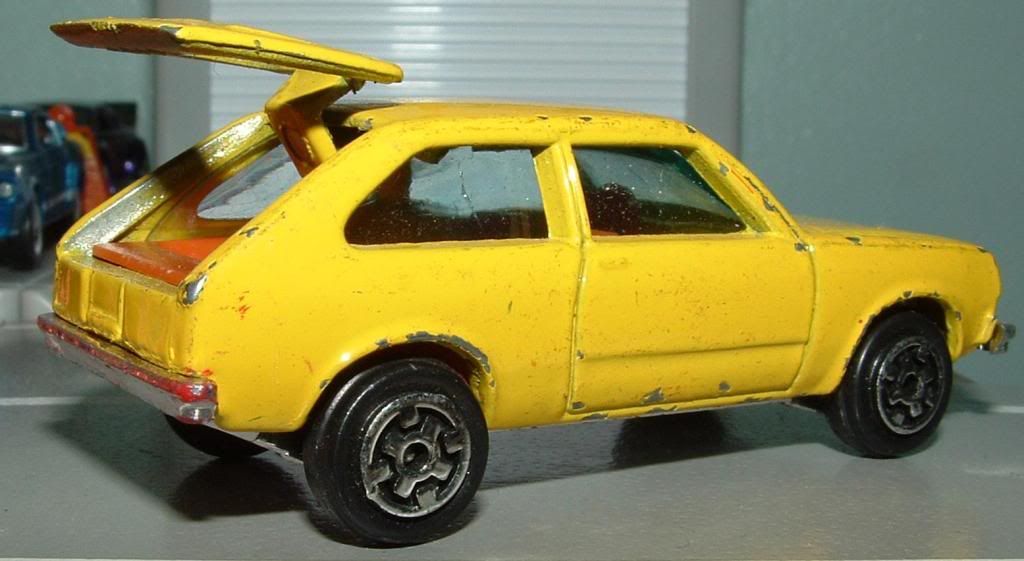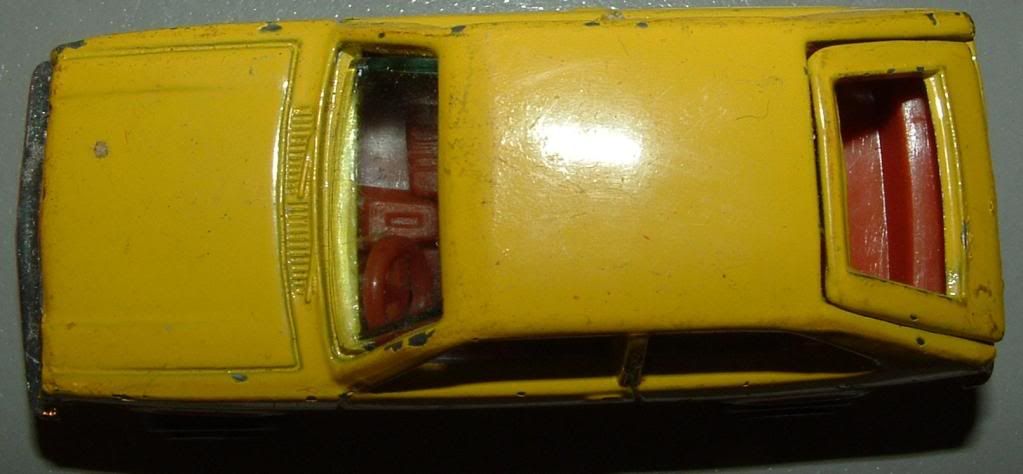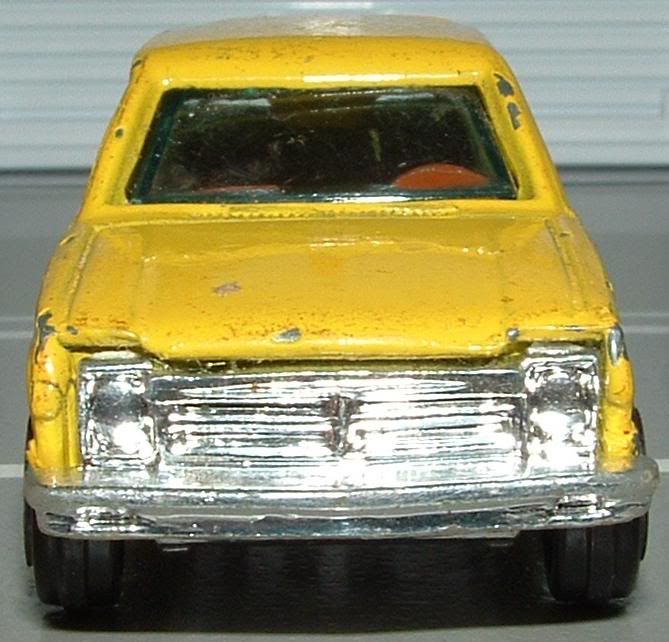
A blog focusing on 1/64 diecast from such popular brands as Hot Wheels, Matchbox, Johnny Lightning, M2 Machines, GreenLight, Tomica, Yat Ming, Majorette, MotorMax, Siku, Corgi, Guisval, Playart, Ertl, Zylmex, Racing Champions, & many more. Swifty's Garage features a daily Car Of The Day and news updates from your favorite brands!
Thursday, November 17, 2011
Car Of The Day: November 17, 2011
Today's car of the day is Kidco's 1979 Chevrolet Chevette.
The Chevrolet Chevette was introduced in September, 1975 and manufactured for model years 1976-1987 based on GM's worldwide T platform and superseding the Vega as Chevrolet's entry-level subcompact. The Chevette was the best-selling small car in America for 1979 and 1980, and was popular in South America as well.
For more information and pictures of the real car please visit: Chevrolet Chevette
The way the chrome bumpers have lost their plating in places makes it look like the car has some rust...a common affliction of the real cars.
The T-car was first launched in Brazil under the Chevette name in 1973, as a two-door sedan; the Brazilian Chevette line eventually included a four-door sedan, a two-door hatchback, and a two-door station wagon (named Marajó), as well as a pickup (named the Chevy 500), and was produced until 1994. Chevettes are also a car used in racing in Dirt Track Racing. It has its own series. The Chevette was probably the last rear-wheel drive FR subcompact built in the world (produced until 1998 in Colombia; the VW Beetle was built in Mexico until 2003 but it had a different layout, namely rear-wheel drive, rear engine) until BMW launched its 1 Series in 2004.
Initially available only as a two-door hatchback with 1.4 or 1.6 L OHC gasoline inline-four engines, the Chevette engines produced from 53 to 70 horsepower (40 to 52 kW) at the rear wheel. A four-speed manual transmission was standard; a three-speed automatic transmission was optional. Rally and Woody packages were optional, as well as a loss-leader Scooter, a two-seater (rear seat optional) with painted rather than chromed bumpers, an open glove box, black carpeting, and door pull straps in lieu of arm rests. The Canadian market also had a Pontiac version of Chevette named Acadian. As the smallest, most fuel-efficient car marketed by Chevrolet, it was the lightest American car at the time being offered, weighing in at under a ton. The EPA rated the base 1.4-liter engine at 28 miles per US gallon (8.4 L/100 km; 34 mpg-imp) city and 40 miles per US gallon (5.9 L/100 km; 48 mpg-imp) highway—figures unheard of in past domestic models. Chevrolet claimed that a Chevette's turning circle (30.2 feet) was one of the smallest in the world and that it was essentially a "metric" car, "international in design and heritage."1976-1978 Chevettes can be identified by round headlights and a chrome-rimmed, tri-color taillights.
The Chevette Rally 1.6, included a 1.6-liter (98 cu in) engine in lieu of the 1.4-liter (85 cu in) overhead-cam four-cylinder, rated at 60 hp (45 kW) instead of 52 hp (39 kW). The Rally also featured a suspension with rear stabilizer, along with special body graphics. Through model year 1976, the Chevette Woodie carried wood simulating sheet-vinyl trim and upgraded interior/exterior trim. The Woody model has become quite scarce, especially in higher condition grades. Chevrolet marketed the Chevette Scooter model with a MSRP of $2,899, without a rear seat or glovebox door. 9,810 Scooters were built, versus 178,007 regular hatchbacks. Buyers could choose either a fully synchronized floor-shifted four-speed manual transmission or optional Turbo-Hydramatic. Chevettes had rack-and-pinion steering, front disc brakes, a front stabilizer bar, 13-inch tires, tri-color taillights, front bucket seats, and an onboard diagnostic system. Swing-out rear quarter windows were optional.
The 1977 Chevrolet Chevette's engines offered 57 hp (43 kW) or 63 hp (47 kW). The Scooter hatchback included a rear seat. The Sandpiper trim package included “reef” patterned interior, deluxe door trim, cream gold or antique white exterior colors and an exterior Sandpiper logo just behind each door.
1978 models had a revised grille with a grid design, grille and headlight frames chromed for standard models, a four-door hatchback riding a 97.3 inches (2,470 mm) wheelbase was added — two inches longer than the two-door — and this version accounted for more than half of Chevette's nearly 300,000 sales. The 1.4 L engine and Woody were dropped. Fuel door added. TH-180 Automatic Transmission added to replace THM-200 series automatic. "HO" High Output version available in addition to the standard 1.6 L featuring a modified head and larger valves/cam profile. "HO" package also includes dual outlet exhaust manifold. Prices dropped and more standard equipment was added for 1978.
In 1979, the Holley two-barrel carburetor was now standard on all models. The front fascia was face-lifted with a flat hood, no longer wrapping down to bumper. New for 1979 was a large chrome grille with Chevrolet "Bow-Tie" emblem and square headlights. P.A.I.R. air injection system was introduced to improve catalytic converter function at idle. Active Passenger Restraint system was introduced in small numbers as an option which featured lower hanging dashboard, automatic seatbelts and a center dash console. Chevette sales totaled more than 451,000 units — a figure that would rank it second only to Chevy's new Citation, which had a much longer model run (sales had started in April 1979). Consumer Guide testers managed "an honest 29 mpg in the city and 39 mpg on the highway." The 1980 rear fascia was revised with a squared-off hatch, wraparound taillights with combined, single colored turn signals and a round gas filler door.
Subscribe to:
Post Comments (Atom)







No comments:
Post a Comment